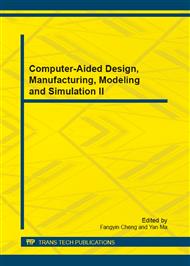[1]
Wang chengyuan, Xia jiakuan, Sun yibiao. Modern control technique of electric machines[M]. Beijing: China machine press, 2009: 162-177.
Google Scholar
[2]
J. Beerten, J. Verveckken,J. Driesen. Predictive Direct Torque Control for Flux and Torque Ripple Reduction [J]. IEEE Transactions on Industrial Electronics, 2010, 57(1): 404-412.
DOI: 10.1109/tie.2009.2033487
Google Scholar
[3]
Wang Jing-xin, Jiang Jian-guo. Variable- structure Direct Torque Control for Induction Motor Driven by a Matrix Converter Based on Field Oriented[J]. Proceedings of the CSEE, 2012, 30(6): 57-62.
DOI: 10.1109/ipemc.2009.5157453
Google Scholar
[4]
Yongchang Zhang, Jianguo Zhu, Zhengming Zhao, et al. An Improved Direct Torque Control for Three-Level Inverter-Fed Induction Motor Sensorless Drive[J]. IEEE Transactions on Power Electronics, 2012, 27(3): 1502- 1513.
DOI: 10.1109/tpel.2010.2043543
Google Scholar
[5]
X. del Toro Garcia, A. Arias, M. G. Jayne et al. Direct Torque Control of Induction Motors Utilizing Three-Level Voltage Source Inverters[J]. IEEE Transactions on Industrial Electronics, 2008, 55 (2): 956-958.
DOI: 10.1109/tie.2007.896527
Google Scholar
[6]
M. R. Douiri, M. Cherkaoui, A. Essadki. A neuro fuzzy PI controller used for speed control of a direct torque to twelve sectors controlled induction machine drive[A]. Proceedings of 2011 International Conference on Multimedia Computing and Systems[C], 2011: 1-6.
DOI: 10.1109/icmcs.2011.5945686
Google Scholar
[7]
Xie shunyi, Hu daping. Study of Asynchronous Machine Direct Torque Control based on Lag loop Stata Selector [J]. Power Electronics, 2005, 39(1): 98-100.
Google Scholar
[8]
V.N. Vapnik. The Nature of Statistical Learning Theory [M]. Springer, New York, (1995).
Google Scholar
[9]
Chen Jie, Zhu lin. New identification approach for nonlinear systems based on the combination network model of least squares and support vector machines[J]. Control Theory & Applications, 2010, 27 (3): 303-309.
Google Scholar
[10]
Song Jian-cheng,Zheng Jian-bin,Qu Bing-ni. Modeling and simulation for switched reluctance motor based on least squares support vector machine[J]. Electric Machines and Control, 2010, 14 (5): 44-48.
Google Scholar


